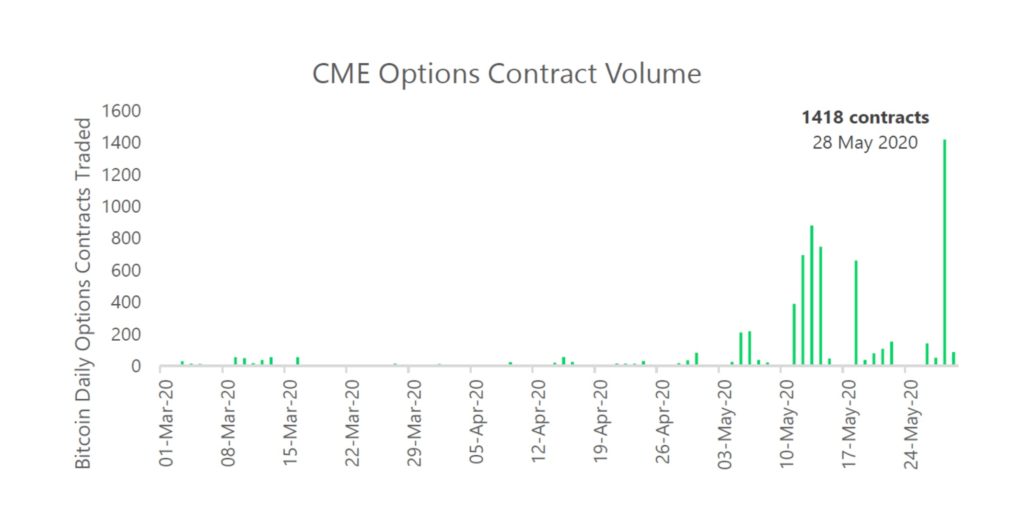
Key Highlights
Crypto Derivatives Volumes Hit an All-time High in May
Derivatives volumes across all platforms soared in May. Volumes for all crypto derivatives increased 32% in May to an all-time high – totalling $602 bn.
What’s more, crypto derivatives are gaining market share. Total spot volumes increased only 5% to $1.27 tn in May, which meant that derivatives represented 32% of the market, compared with 27% in April.
Institutional Options Volumes Hit Record Levels
May saw volumes on regulated platform CME soar, recovering substantially from a lull in April.
Options are one area seeing particularly impressive growth. CME total options volumes reached an all-time monthly high of 5,986 contracts traded in May. This figure represents 16 times that of April’s volumes. CME futures volumes have also recovered since April, increasing 36% (number of contracts) to reach 166,000 in May.
More broadly, May saw volumes for CME Bitcoin derivatives soar 59% to hit $7.2bn, a monthly increase greater than any other derivatives exchange (both regulated and non-regulated).
Deribit Sees Record Options Volumes
Derivatives exchange Deribit has seen another daily record, trading $196mn in options on the 10th of May, the highest ever seen on the platform.
In May Deribit’s monthly options volume also reached another all-time high, trading $3.1bn (up 109%) to double the volume seen in April ($1.5bn).
10th of May sees Huge Spot Volumes
The 10th of May saw another surge in trading volume totalling $64.7bn. While significant, this does not match the volume spikes seen on the 30th April ($66.2bn) and the record volumes seen on the 13th of March ($75.9bn). The majority of this figure is represented by Lower Tier exchanges ($49.9bn) while Top Tier exchanges traded $14.9bn.
Exchange Benchmark Analysis
CryptoCompare’s Exchange Benchmark aims to serve investors, regulators and crypto enthusiasts by scoring exchanges in terms of transparency, operational quality, regulatory standing, data provision, management team, and their ability to monitor trades and illicit activity effectively. Rather than drawing attention specifically to bad actors, we instead highlight those that behave in a manner that is conducive to maintaining an efficient and fair market, ensuring greater safety of investors. We have hence introduced the notion of “Top-Tier” vs “Lower-tier” volumes.

In May, Top Tier volumes increased 12.6% to $275bn, while Lower Tier volumes only increased 0.2% to $858bn.

The 10th of May saw another surge in trading volume totalling $64.7bn. While significant, this does not match the volume spikes seen on the 30th April ($66.2bn) and the record volumes seen on the 13th of March ($75.9bn). The majority of this figure is represented by Lower Tier exchanges ($49.9bn) while Top Tier exchanges traded $14.9bn.
Categorising exchanges by tier level based on our rigorous Exchange Benchmark methodology helps us capture a more representative picture of where the market has moved. As seen, Top Tier exchanges saw a similar spike in volume on the 10th of May.

Macro Analysis and Market Segmentation

Exchanges that charge traditional taker fees represented 77% of total exchange volume in May, while those that implement Trans-Fee Mining (TFM) represented less than 23%. Last month, fee charging exchanges represented 78% of total spot volume.
Fee-charging exchanges traded a total of $868bn in May (up 1% since April), while those that implement TFM models traded $256bn (up 9% since April).

In May, volume from many of the largest Top Tier exchanges increased 26% on average (vs April).

Binance was the largest Top Tier exchange by volume in May, trading $57.2bn (up 18.2%). This was followed by OKEx trading $52.1bn (up 25.7%), and Coinbase trading $11.2bn (up 22.4%).

Binance and OKEx remained the top players in terms of volume in May relative to other Top Tier exchanges.
Bitcoin to Fiat Volumes

BTC trading into USDT decreased 7% in May to 14.9mn BTC vs 16.1mn BTC in April. In contrast, trading into USD and JPY increased to 2.0mn BTC (up 12%) and 1.5mn BTC (up 28%) respectively. The EUR and KRW markets saw increases of 17% and 21% respectively.
Stablecoins USDC and PAX saw a large drop in total volume traded into BTC. BTC/USDC and BTC/PAX markets traded 0.18mn BTC (down 78%) and 0.03mn BTC (down 97%) respectively in May.


The BTC/USDT pair still represents the majority of BTC traded into stablecoins at ~98%. BTC/USDC and BTC/PAX have lost the market share gained in previous months and now only represent less than 2% combined.
Derivatives

Derivatives volume increased 32% in May to an all-time high, totalling $602bn. Meanwhile, total spot volumes increased 5% to $1.27tn. As a result, derivatives represented 32% of the market in May (vs 27% in April).


All derivatives saw large increases in trading volume in May, with institutional player CME increasing the most at 59% to $7.2bn.
Huobi was the largest derivatives exchange, and traded $176bn (up 29% since April). OKEx and Binance followed with $152bn (up 33%) and $139bn (up 58%) respectively.
BitMEX traded $94.8bn in May (up 37%) while Deribit saw an increase of 22% to $13.4bn.

Despite the large increase in volume since the previous month to reach an all-time high, in May there were no record daily volumes witnessed among the top players.
Options

Derivatives exchange Deribit has seen another daily record, trading $196mn in options on the 10th of May. In May Deribit’s monthly options volume has also reached another all-time high, trading $3.06bn (up 109%) to double the volume seen in April ($1.47bn).

CME Institutional Volume

CME futures volumes have recovered since April, increasing 36% (number of contracts) to reach 166,000 in May. Meanwhile, CME total options volumes reached an all-time monthly high of 5,986 contracts traded (16 times April’s volumes).
May also represented an all-time high in daily options volume, with CME trading 1,418 Bitcoin options contracts on the 28th of May.


